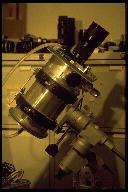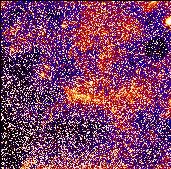The DWARF Camera System
Deep sensing Wide Angle Recording Facility
Till Credner, 1996
Why to put a big professional CCD-System together with a
small camera lens and use this in Astronomy?
Deep sensing Wide Angle Recording Facility
Till Credner, 1996
Why to put a big professional CCD-System together with a
small camera lens and use this in Astronomy?
When imaging extended objects, the focal ratio of the optics
gives the photon density at the focal plane. So no matter if a
big 1m-Schmidt telescope with f/2 or a small f/2 camera lens is used,
the same detector yields the same limiting magnitude for the surface
brightness. On the other hand big Schmidt Telescopes have
a high resolution. But how to substitute an unsensitive 50 x 50
cm2 photographic plate with such a big CCD system? This
is still almost impossible. And the advantages of CCDs are their high
quantum efficiency, the large dynamic range and the linearity.
So in all this means:
Attaching a CCD-Camera to a small optics, a much better
sensitivity to extended objects is reached than with a big
photographic Schmidt-Telescope at the same focal ratio.
And due to the large dynamic range, the linearity and the direct
digital presence of the data, the scientific content is much higher.

| The DWARF just before it has seen the first light. It was installed on
a small amateurs mount.
Realisation |
| Comet C/1996 B2 (Hyakutake) observed from Hoher List (25.3.96, Exposure 180s). For observing comets not only the large field of view but also the speed of the camera system is of special importance. Tail structures can change very fast, so that short exposures are necessary to get sharp images and to follow these temporal changes. |

|

| The extended, but very faint Galactic Cirrus in Ursa Major detected with the DWARF (10.3.96, Exposure 3 x 10 min, Hoher List). It was first found by Alan Sandage 1975 with the 1.2m-Palomar Schmidt Telescope on a four hour (!) exposure. The surface brightness is 25 mag/(")2 or even fainter (Sandage, A.: 1976, AJ81, 954). Compare this image with one taken by the infrared satellite IRAS. |
| CCD-Chip | Optics | |
|---|---|---|
| Ford Loral | | |
| 20482 pixel | f=100mm, f/2.0 | f=200mm, f/4.0 |
| Size 3 x 3 cm2 | Field of View: 17 x 17 degrees2 | 8.6 x 8.6 degrees2 |
| Pixel size 15 x 15 micron2 | Scale: 30 "/pixel | 15 "/pixel |
Astronomical Institutes of the University of Bonn
Till Credner (credner@allthesky.de)